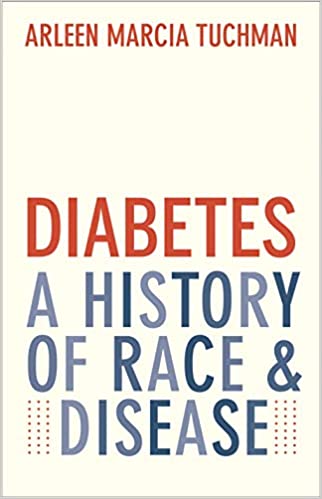

Diabetes: A History of Race and Disease
Arleen Tuchman
Who is considered most at risk for diabetes, and why? In this thorough, engaging book, historian Arleen Tuchman examines and critiques how these questions have been answered by both the public and medical communities for over a century in the United States.
Beginning in the late nineteenth century, Tuchman describes how at different times Jews, middle‑class whites, American Indians, African Americans, and Hispanic Americans have been labeled most at risk for developing diabetes, and that such claims have reflected and perpetuated troubling assumptions about race, ethnicity, and class. She describes how diabetes underwent a mid-century transformation in the public’s eye from being a disease of wealth and “civilization” to one of poverty and “primitive” populations.
In tracing this cultural history, Tuchman argues that shifting understandings of diabetes reveal just as much about scientific and medical beliefs as they do about the cultural, racial, and economic milieus of their time.
Arleen Marcia Tuchman, professor at Yale University, created an incredibly thorough review of the history of diabetes as it relates to race in the United States. What really stands out is the repeated blame of patients for their health challenges related to diabetes of any type. Health care leaders in diabetes, including Dr. Elliot Joslin, describe failure to adhere to the prescriptions from the doctor as a fault in their moral character. This was a pattern of judgment from doctors against their patients with diabetes of all races, but particularly of minorities as well as people with type 2 diabetes, once called Non-Insulin Dependent Diabetes Mellitus (NIDDM).
Tuchman describes countless efforts to link particular populations to genetic predisposition for diabetes as well as research focused on what were called “primitive” populations such as Native peoples throughout the U.S. What was particularly surprising is how little evidence was actually found tying genetics to racial populations and how many continued to publish articles claiming racial genetics or a biological component of race. There were also many who believed that industrialization and the stress of capitalism contributed to the rise in diabetes for all populations in the U.S. as early as the early 20th century.
Despite continued warnings about excess mortality among minority populations such as Black Americans, Native Peoples throughout the Southwestern U.S., and those who lived in poverty, the disparities seen throughout the last century persist today, and are explained by Tuchman. Given the amount of literature and society’s sentiment that diabetes is a self-inflicted condition, the author is not surprised that the problems persist. There are many who have advocated for the environmental challenges that increase the risk for diabetes, and Tuchman suggests more needs to be done to reduce the environmental factors and decrease the risks.
Tuchman also provides insight into the type 1 diabetes community, once called juvenile diabetes, then insulin-dependent diabetes mellitus (IDDM), from the discovery of insulin through the mid-2000’s. She looks at historical and current stereotypes about minorities and diabetes. For decades, minorities were thought to not be affected by diabetes as much as Anglo-Americans, when in fact it was simply under-reported. These stereotypes have since morphed into the belief that minorities in the U.S. only get type 2 diabetes as a result of social determinants of health causing them to struggle to eat healthy and exercise to reduce their risks. The reality is that type 1 diabetes, and type 2 for that matter, affect people of all races, genders, and geographical locations.
The historical perspective of this book gives the reader insight into the challenges we face today as a society related to diabetes care, prevention, and racial disparities. It is encouraging to see that we are moving forward in some ways, and helps provide insight to what needs to be done.
Marissa Town, BSN, RN, CDCES
288 pages, Yale University Press, ISBN 978-0300228991, $23.402020

